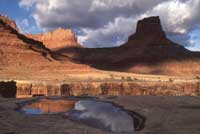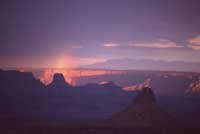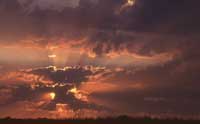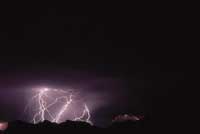 August is not the average warmest month in Moab, but it can be bloody hot. The warmest month honor goes to July. Nor is it the wettest month – October takes that prize. June wins the driest and January the coldest month awards. Maybe August gets the skyscape honorable mention, as thunderstorms and cloudy weather initiate the transition from summer to fall, and produce incredible skyscapes morning, noon and night.
August is not the average warmest month in Moab, but it can be bloody hot. The warmest month honor goes to July. Nor is it the wettest month – October takes that prize. June wins the driest and January the coldest month awards. Maybe August gets the skyscape honorable mention, as thunderstorms and cloudy weather initiate the transition from summer to fall, and produce incredible skyscapes morning, noon and night.
Chance of afternoon thunderstorms is the daily Moab weather prediction for July and August. Ironically, this is the hottest time of year, but also the monsoon season. Summer temperatures heat up the Pacific Ocean and Interior West at different rates. The Southwest landscape heats up faster than the ocean, which causes a low-pressure ridge to form over the region. This pressure difference drives moisture-laden winds from the ocean to flow into the region. Rising over mountain ranges the air starts to cool and condense into clouds; sufficient build-up leads to thunderheads and the chance of rain.
Sometimes the rain happens but it evaporates before it reaches the ground. Thin veils called virga draw across the landscape, but never connect earth to sky. The rain or ice crystals evaporate like a broken promise. Of course, there are other days when hard rains accompany lightning storms that electrify the sky and turn dry washes into torrents.
Some of these storms are fast moving. Photographers wishing to record these events have to be ready to move. A tripod and camera capable of long exposures is crucial, as well. An open shutter can pick up multiple lightning strikes, blending the bolts into a single image. Here again, safety is paramount. Counting the seconds between lightning flash and thunder is one way to judge distance of the storm. Five seconds equals about 1 mile of distance, and lightning less than 3 miles away is reason to run for cover. Successive strikes may occur within 2-3 miles of each other, which isn’t a very big safety net.

In addition to the dramatic cloudscapes, summer sunsets and sunrises offer additional opportunities to witness some spectacular sky scenes. There are classic viewpoints like the Windows, Grandview Point or Dead Horse Point State Park that provide “big sky” views and may offer great vantage points from which to watch these skyscapes unfold.
Though the cliffs and arches create a dramatic juxtaposition between earth and sky, at times, I like using smaller subjects to create depth of field or to record the skyscape. This might be reflections in puddles, backlight wildflowers or solitary trees that create a contrast. A close-up of people with a raging sky behind them produces a contrast between tranquility and the looming storm. Remember that during an electrical storm hair standing straight up is a sign that someone is in imminent danger of being struck by lightning.
No matter if you’re a photographer or just a sky watcher, the drama that unfolds above the ground is, at times, as spectacular as the red rock scenery itself. Pay attention to that distant rumble of thunder and beware of lightning. But also take in the drama above you – the desert skyscapes are a world unto themselves.


